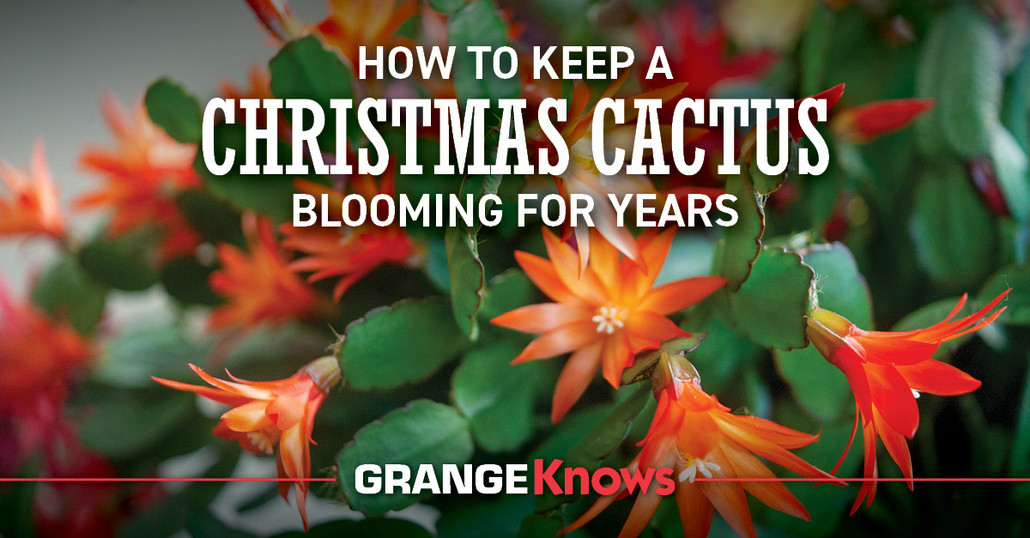
How to Keep a Christmas Cactus Blooming for Years
Posted by Grange Co-op on 13th Nov 2023
If the rich red blooms of poinsettias pop into your head when you think of Christmas, you aren't alone. Many people think of the flower as a traditional part of the holidays. But there's another popular plant that produces colorful blooms throughout the holiday season: the Christmas cactus. While the poinsettia typically blooms for one season, the Christmas cactus will keep blooming year after year.
Separating Christmas Cactus from the Holiday Pack
There are actually three types of holiday cacti out there that look very similar. These include the Christmas cactus, the Thanksgiving cactus, and the Easter cactus. All are hybrids of Brazilian forest cacti. Both the Thanksgiving and Christmas cacti belong to the genus Schlumbergera.
The main difference between these two plants is the shape and structure of the leaves. A Thanksgiving cactus has spikier leaves, while those of a Christmas cactus are smoother and more rounded. Thanksgiving plants also have yellow pollen-bearing anthers, while those on the Christmas cactus are pink.
Despite the difference in their names, both plants bloom from mid-November to late December or January. Either plant can also bloom between March and May. It isn't unusual for both plants to be sold as Christmas cactus, and people often enjoy them each the same.
The third holiday plant, the Easter cactus, belongs to the genus Rhipsalidopsis, which grows in drier forests. The Easter cactus blooms in late winter and spring. The flowers of this plant are usually pink and trumpet-shaped.
Both plants produce blooms in shades of red, pink, lavender, orange, and white. Yellow is the rarest color of all. Everything that applies to caring for a Christmas cactus applies to a Thanksgiving cactus too!
Like All Cacti, a Christmas Cactus Is a Succulent
Succulents are plants with thick, fleshy tissues that store water. Some types of plants store water in their leaves, while others store it in their stems. All cacti are succulents, but there are succulents that aren’t cacti.
These plants are easy to care for indoors – with rewarding results. One of the most amazing facts about a Christmas cactus is that it can live up to 100 years! You may choose to keep them as décor for your home, hand them down to the next generation, or give them as holiday gifts. They are easy to care for – a little extra attention can ensure that your plants keep blooming and live for a long time.
Caring for Your Christmas Cactus
These plants do best in deeper pots with at least one drain hole. If your plant comes in a small pot, consider upgrading to the next larger size. A Christmas cactus usually blooms better when it is pot-bound. To create the appearance of a larger, fuller plant, put more than one together in a larger container. Plant two or more of the same color, or mix different colors for a unique look.
How to Repot
Use potting soil that is light and drains well, such as that made for cacti. Fill the pot to about 2 inches below the top.
If you postpone repotting until after it grows, wait until after it stops blooming and the flowers wilt. You will have to repeat this process over time when the plant grows and the roots fill the pot, probably every 3 to 5 years.
Where to Grow
Christmas cactus thrives in cooler temperatures, between 60 and 70 degrees Fahrenheit. You can keep the plant outdoors during the summer in a cool, partly shaded location. Indoors, place it in an east- or west-facing window for moderate light and some direct sun.
While blooming, water the plant modestly to keep the soil moist, not soggy. Christmas cactus is prone to root rot. Don’t over-water, and don’t let water sit in saucers beneath the plant. Use a plant mister frequently to keep the entire plant moist without saturating it.
To make the plant bloom, keep it in a cool environment, and alternate between 10 hours of light and 14 hours of darkness for about a week. Start this process about 6 to 8 weeks before you want it to bloom. Once you see buds, you can leave the plant wherever you want it.
Feed the plant with succulent plant food every 2 weeks once buds develop.
How to Propagate
There is something special about using pieces of your treasured succulent to create new plants to give as gifts. It's simple to take cuttings from your plant to grow new succulents for friends and family. The best time to propagate these plants is 2 months after they finish blooming.
Follow these steps to propagate your succulent:
- Fill a small pot with the appropriate potting soil.
- Take cuttings that are between one and four segments. Set them in a dry, cool area for the cut end to dry.
- Place the cutting 1 inch into the soil.
- Add water to keep moist.
- Cover the plant with plastic, and leave it secured until roots form, usually in 2 to 3 weeks.
You can also root the cuttings in water. Place them in 1 or 2 inches of water and then in indirect light. It may take several weeks for the roots to form. Once they reach 2 inches in length, transfer the cuttings to the soil.
Stop by Grange Co-op for Seasonal Holiday Plants
At Grange Co-op, we have Christmas cactus, paperwhites, and other popular flowers during the appropriate season. Plus, our range of pots and planters, potting soil, and plant food includes everything you need to help your plants thrive. Take a look at our holiday products for ways to boost your holiday décor. If you have questions about your garden project or our products, contact us today – a Grange Co-op expert is ready to answer your questions.
